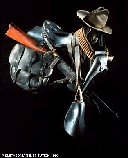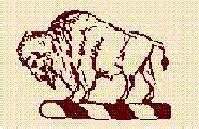The Buffalo Soldiers:
Forgotten Heroes of the West
by
Brenna Farrell
 The Buffalo Soldiers
were formed in 1866 following the end of the Civil War. These six regiments
were made up of Black soldiers, many of whom had fought in the Civil War
and wanted to continue as freedman in the Army. It offered good pay ($16/month)
and steady work, things not easy for freed Blacks to find in 1866. The Buffalo
Soldiers, however, were commanded by white soldiers only and many of these
white soldiers requested a bonus to work with Blacks. Custer even turned
down a commission with the Buffalo Soldiers. It would take more than amendments
to the constitution to bring about integration in both the North and the
South.
The Buffalo Soldiers
were formed in 1866 following the end of the Civil War. These six regiments
were made up of Black soldiers, many of whom had fought in the Civil War
and wanted to continue as freedman in the Army. It offered good pay ($16/month)
and steady work, things not easy for freed Blacks to find in 1866. The Buffalo
Soldiers, however, were commanded by white soldiers only and many of these
white soldiers requested a bonus to work with Blacks. Custer even turned
down a commission with the Buffalo Soldiers. It would take more than amendments
to the constitution to bring about integration in both the North and the
South.
Two of the six regiments, the only two Cavalry units, served in the Western
states from 1866 to 1891 when they were transferred to the Dakotas. During
the time they served in the West, they fought in most of the major battles
against the Indians, who named them the Buffalo Soldiers because of their
curly hair. Many of the soldiers received the Congressional Medal of Honor
for their heroism. During the 1900's, the Buffalo Soldiers served in Cuba
with Teddy Roosevelt's Rough Rider's and fought in World Wars I and II.
These soldiers were also responsible for building telegraph lines, mapping
the southwest, protecting workers, building the railroad tracks that would
unite East and West, and building forts around which towns sprang. Without
their service, the American West would not have grown as quickly as it did.These
soldiers were often stationed in the worst outposts of America, and endured
harsh conditions while performing their duties. Their commander, Colonel
Hatch, wrote "... the work performed by these troops is most arduous,
horse worn to mere shadows, men nearly without boots, shoes, and clothing."
They also faced prejudice from the townspeople they protected.
The 9th Cavalry Unit was formed in Greenville, Louisiana on September
21, 1866. In 1875, they were transferred to New Mexico. Here they fought
the Apache war chiefs Victorio, Geronimo, and Nana. After 14 years of continuous
battle with the Apaches, the 9th was transferred to Fort Riley, Kansas and
later, to Fort Reno in Oklahoma, then known as Indian Territory. During
this time, they protected the Indians from white settlers attempting to
settle on Indian land. The following years, the 9th was moved to Wyoming,
Nebraska and Utah. They were used in 1891 to quell the Sioux in the Ghost
Dance campaign. The Sioux had engaged in a religion which involved the Ghost
Dance to ask ancestors to come to the aid of the tribes. The whites were
fearful. This campaign ended at the massacred of the Sioux at Wounded Knee,
however, the 9th Cavalry did not take part in this battle, but this was
their last campaign.
 The 10th Cavalry unit was
formed at the same time as the 9th Unit, but in Fort Leavenworth, Kansas.
They served in Kansas and Oklahoma for ten years, providing protection for
railroad workers and stringing telegraph lines. They also patrolled the
reservations to prevent Indians from moving into Texas. They eventually
served in Texas and New Mexico. Together with the 9th Cavalry, they chased
Apache War Chief Victorio into Mexico. In 1885, they were moved to Arizona,
where they participated in the campaign against Geronimo. Their final post
was in Montana and the Dakotas. They disbanded in 1898.
The 10th Cavalry unit was
formed at the same time as the 9th Unit, but in Fort Leavenworth, Kansas.
They served in Kansas and Oklahoma for ten years, providing protection for
railroad workers and stringing telegraph lines. They also patrolled the
reservations to prevent Indians from moving into Texas. They eventually
served in Texas and New Mexico. Together with the 9th Cavalry, they chased
Apache War Chief Victorio into Mexico. In 1885, they were moved to Arizona,
where they participated in the campaign against Geronimo. Their final post
was in Montana and the Dakotas. They disbanded in 1898.
One of the most interesting stories about the Buffalo Soldiers was that
a woman pretended to be a man and served in the 38th Infantry, one of four
infantry units. Her name was Cathay Williams and she was a slave at the
time of the Civil War. When her master died, she joined one of the Union
Army units as a cook. She joined the Buffalo Soldiers in 1866 pretending
to be William Cathay. She said she joined the Army because she did not want
to depend on anyone. She served in New Mexico and in Kansas. I could not
find when she was discharged and the title for the article had the dates
wrong. Her commander said that she was a "good soldier".
In 1992, William Colin Powell dedicated a memorial to the Buffalo Soldiers
in Fort Leavenworth, Kansas. Despite this, not much is written about the
Buffalo Soldiers in our history books. I did this report because when I
studied the Westward Expansion, nothing was said about these soldiers in
my history book. My Mom told me about them. It is really sad that the contributions
of Blacks in America is not mentioned in our history.
Bibliography
N.A. (nd). No title. National Historical and Preservation Insitute. Online:
http://www.zianet.com/wblase/courier/buffalo.htm
N.A. (nd). The Buffalo Soldiers on the Western Frontier. The International
Museum of the Horse. Online: http://www.imh.org/imh/buf/buftoc.html
N.A. (nd). The Historical Desert: The Buffalo Soldiers :"Where
they went, peace and civilization followed.". Bureau of Land Management.
Online: http://www.desertusa.com/mccain/oct_buffalo.html
Savage, Cynthia (1997). Cathay Williams, Black Woman Soldier 1886-1887.
Oral Presentation to the West Texas Historical Society. Online: http://www.femalebuffalosoldier.org/cynthiasavage_pg1.html
Stiles, T.J. (1998). Abstract of an article by T. J. Stiles originaly
published in December, 1998 Smithsonian Magazine. Smithsonian. Online: http://smithsonianmag.com/smithsonian/issues98/dec98/buffalo.html
 Author: Brenna Farrell
Author: Brenna Farrell
(c)2001
 The Buffalo Soldiers
were formed in 1866 following the end of the Civil War. These six regiments
were made up of Black soldiers, many of whom had fought in the Civil War
and wanted to continue as freedman in the Army. It offered good pay ($16/month)
and steady work, things not easy for freed Blacks to find in 1866. The Buffalo
Soldiers, however, were commanded by white soldiers only and many of these
white soldiers requested a bonus to work with Blacks. Custer even turned
down a commission with the Buffalo Soldiers. It would take more than amendments
to the constitution to bring about integration in both the North and the
South.
The Buffalo Soldiers
were formed in 1866 following the end of the Civil War. These six regiments
were made up of Black soldiers, many of whom had fought in the Civil War
and wanted to continue as freedman in the Army. It offered good pay ($16/month)
and steady work, things not easy for freed Blacks to find in 1866. The Buffalo
Soldiers, however, were commanded by white soldiers only and many of these
white soldiers requested a bonus to work with Blacks. Custer even turned
down a commission with the Buffalo Soldiers. It would take more than amendments
to the constitution to bring about integration in both the North and the
South. The 10th Cavalry unit was
formed at the same time as the 9th Unit, but in Fort Leavenworth, Kansas.
They served in Kansas and Oklahoma for ten years, providing protection for
railroad workers and stringing telegraph lines. They also patrolled the
reservations to prevent Indians from moving into Texas. They eventually
served in Texas and New Mexico. Together with the 9th Cavalry, they chased
Apache War Chief Victorio into Mexico. In 1885, they were moved to Arizona,
where they participated in the campaign against Geronimo. Their final post
was in Montana and the Dakotas. They disbanded in 1898.
The 10th Cavalry unit was
formed at the same time as the 9th Unit, but in Fort Leavenworth, Kansas.
They served in Kansas and Oklahoma for ten years, providing protection for
railroad workers and stringing telegraph lines. They also patrolled the
reservations to prevent Indians from moving into Texas. They eventually
served in Texas and New Mexico. Together with the 9th Cavalry, they chased
Apache War Chief Victorio into Mexico. In 1885, they were moved to Arizona,
where they participated in the campaign against Geronimo. Their final post
was in Montana and the Dakotas. They disbanded in 1898.